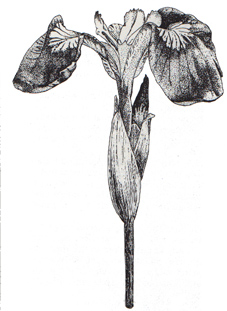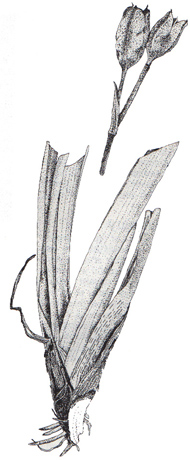

 |
 |
Iris
Iris setosa
(Iridaceae)
Description:
The iris, or blue flag, is a large, beautiful, lilylike
violet-colored flower with markings of other colors. In all irises the mature
flower consists of three large, drooping, petal-like sepals (the falls) outside
of three erect, petaloid stigmas that arch gracefully over the stamen. The sword-shaped,
erect leaves overlap. The stem is stout, straight, almost circular, and sometimes
branching. The fruits--two rows of flat seeds--form in an oblong capsule, and
the root is a cylindrical rhizome, often branched, and compressed toward the
larger end where there are a cup-shaped scar and numerous rings of scars.
Distribution:
The distribution of Iris setosa is around the north
Pacific. (Hulten) The genus Iris is a Northern Hemisphere group. (Gray)
Constituents:
Iris versicolor and I. caroliniana, two other North American
species of iris, contain iridin, isophthalic acid, a camphoraceous substance,
gum tannin, sugar, and oil, according to The Merck Index. The rhizome
of I. versicolor contains starch, gum tannin, volatile oil, acrid resinous
matter, isopphthalic acid, traces of salicylic acid, and possibly alkaloid.
Its medicinal use is due to an oleoresin. (Grieve)
Medicinal uses:
Positive reports on the use of Iris include that
of Smith, who describes the root infusion as a laxative. De Laguna says it is
a magic plant to the Saint Elias people. In Angoon they make tea with iris roots;
others use the whole plant. Anderson (cited in Oswalt) reports the seeds of
iris are used as coffee (see Culinary uses, following).
Iris versicolor is described by Christopher as a cathartic, diuretic, stimulant, emetic, antisyphilitic, resolvent, sialogogue, anthelmintic, hepatic, and purgative. Iris is a powerful liver stimulant, said to be equal to mandrake root and less irritating. It clears the bile ducts of catarrhal obstructions, is beneficial to the secretive glands of the intestines, stimulates the flow of saliva, and is healing to the lymphatic system.
The medicinal action of I. versicolor, according to Grieve, is that iridin acts powerfully on the liver. Fresh iris is quite acrid, and if employed internally produces nausea, vomiting, purging and colicky pains. The dried root is less acrid and is employed as an emetic, diuretic and cathartic. The oleoresin in the root is purgative to the liver, and useful for bilious sickness, in small doses.
"It is chiefly used for its alternative properties, being a useful purgative in disorders of the liver and duodenum, and is an ingredient in many compounds for purifying the blood. It acts as a stimulant to the liver and intestinal glands and is used in constipation and biliousness, and is believed by some to be a hepatic stimulant second only to podophyllin, but if given in full doses it may occasion considerable nausea and severe prostration." (Grieve)
Culinary uses:
In spite of reports that iris root is poisonous (see Warning,
following) I tried some tea from the seeds of the Iris in Fairbanks.
The seeds are very easy to gather after the snow falls--they fall out of the
capsule when you tip it. A handful was gathered in a minute or two.
A French chemist cited in Grieve, who discovered that the seeds produce a beverage similar to coffee and even superior to it in flavor, adds that the seeds must be free from the friable skin that envelops them and must be well-roasted before using. I did not agree. The unroasted seeds of I setosa (he was using I psendacorus) produced a delicious brew. Because the skin of the seed was not friable enough to be easily removed, I ground it up along with the whole seeds in a coffee grinder. (The seeds were too tough and resilient to be cracked in a mortar and pestle.)
Warning:
White reports that iris root is poisonous, and Lewis says that
it is a poisonous glycoside. When ingested it may cause dermatitis due to allergenic
reactions. (Moulton, 1979)
Copyright © 1987 by Eleanor G. Viereck